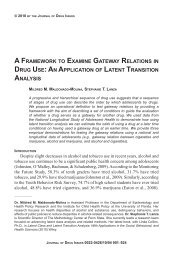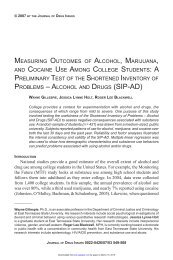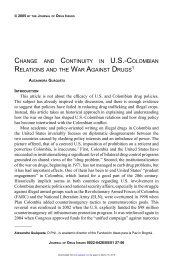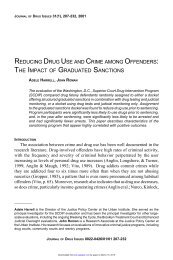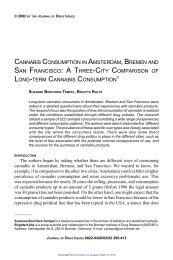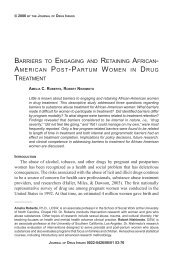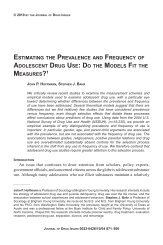a brief history of cannabis policies in spain - Journal of Drug Issues
a brief history of cannabis policies in spain - Journal of Drug Issues
a brief history of cannabis policies in spain - Journal of Drug Issues
Create successful ePaper yourself
Turn your PDF publications into a flip-book with our unique Google optimized e-Paper software.
GAMELLA, JIMÉNEZ RODRIGO<br />
1986). The “problem <strong>of</strong> drugs” had become an <strong>in</strong>stitution <strong>in</strong> the daily life <strong>of</strong><br />
Spaniards.<br />
THE SUDDEN DISCOVERY: AIDS AMONG DRUG USERS<br />
AIDS and HIV were unexpected consequences <strong>of</strong> the spread <strong>of</strong> <strong>in</strong>travenous<br />
drug use <strong>in</strong> Spa<strong>in</strong>. Less than a hundred drug users had been diagnosed by June<br />
1986 (Secretaría del Plan Nacional sobre SIDA, 2003). But <strong>in</strong> the follow<strong>in</strong>g years,<br />
the rate <strong>of</strong> new cases accelerated, and the connection between shar<strong>in</strong>g <strong>in</strong>ject<strong>in</strong>g<br />
paraphernalia and the spread <strong>of</strong> AIDS became undeniably evident. By 1991, Spa<strong>in</strong><br />
had the highest <strong>in</strong>cidence <strong>of</strong> AIDS <strong>in</strong> Europe, and <strong>in</strong>travenous drug use became the<br />
key aspect <strong>of</strong> the spread <strong>of</strong> the pandemic. Amaz<strong>in</strong>gly, this seems to have surprised<br />
much <strong>of</strong> the health care system and the specific agencies that were deal<strong>in</strong>g with<br />
drug use. In the mass media, the connection between drugs and AIDS began to<br />
ga<strong>in</strong> ground <strong>in</strong> 1988. Some experts had alerted <strong>of</strong>ficials that AIDS affected “the<br />
population <strong>of</strong> <strong>in</strong>travenous drug users (IDUs) <strong>in</strong> a different way than <strong>in</strong> other<br />
European countries, except Italy” (Camprubí, 1986, p. 11). Around 1990, the<br />
situation had assumed alarm<strong>in</strong>g proportions. Conservative estimates <strong>in</strong>dicated that<br />
more than 100,000 people were <strong>in</strong>fected (Downs, Heisterkamp, Brunet, & Hamers,<br />
1997; Castilla et al., 1997), and, depend<strong>in</strong>g on the area, most samples showed a<br />
presence <strong>of</strong> the HIV virus <strong>in</strong> 40% to 80% <strong>of</strong> IDUs (Hernández-Aguado, Aviñó, &<br />
Pérez-Hoyos, 1999). Moreover, it was ma<strong>in</strong>ly <strong>in</strong> connection with <strong>in</strong>ject<strong>in</strong>g drug<br />
use that AIDS was be<strong>in</strong>g transmitted to newborn children and to partners <strong>of</strong> IDUs.<br />
Spa<strong>in</strong> was confront<strong>in</strong>g a major health crisis. Despite the urgency <strong>of</strong> the situation,<br />
once aga<strong>in</strong> crucial years passed before more appropriate drug <strong>policies</strong> were<br />
implemented. These lost years may have been very costly <strong>in</strong> terms <strong>of</strong> people <strong>in</strong>fected<br />
and lives lost.<br />
DECREASE IN CANNABIS CONSUMPTION<br />
The use <strong>of</strong> hashish and marijuana seems to have decreased <strong>in</strong> the second half <strong>of</strong><br />
the 1980s. In 1993, a major review <strong>of</strong> illicit drug use <strong>in</strong> Spa<strong>in</strong> concluded that<br />
<strong>cannabis</strong> “was the illegal drug most <strong>of</strong>ten used, and more available, but <strong>in</strong> the<br />
1980s, the prevalence <strong>of</strong> its consumption dim<strong>in</strong>ished among the general population,<br />
among those admitted for treatment for drug dependence, and perhaps among high<br />
school students.” (Barrio, de la Fuente et al., 1993, p. 348). Accord<strong>in</strong>gly, demands<br />
<strong>of</strong> treatment for <strong>cannabis</strong>-related problems rema<strong>in</strong>ed very low, between 1% to 2%<br />
<strong>of</strong> all those related to illicit drugs (Barrio, de la Fuente et al.), and many <strong>of</strong> these<br />
referrals might have been made by poly-drug users or by parents alarmed by the<br />
smok<strong>in</strong>g habits <strong>of</strong> their <strong>of</strong>fspr<strong>in</strong>g, rather than by the users themselves (Gamella &<br />
Jiménez Rodrigo, 2003). The image <strong>of</strong> hashish and marijuana may have been ta<strong>in</strong>ted<br />
634 JOURNAL OF DRUG ISSUES<br />
Downloaded from jod.sagepub.com by guest on March 15, 2015








